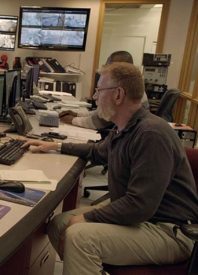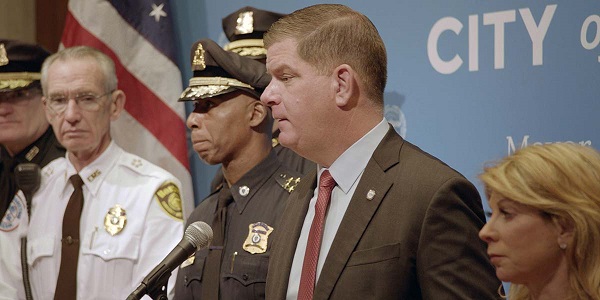
(In The Seats published a shorter version of this review of City Hall during TIFF. This longer version exists because I didn’t feel like being lazy today, because this film deserves effort).
City Hall is Frederick Wiseman’s exploration of the local government in Boston, Massachusetts. It goes without saying that it takes a lot to run a city. But the documentary makes its audience feel the multiple facets of doing so. The movie takes us to press conferences, committee meetings and community lunches. And that’s just ten minutes out of its four and a half hour long run time. And those ten minutes presumably depicts a week in the city’s life. The film begins its exploration around the time that the Red Sox won the 2018 World Series.
Sure, sports championships parades are great, but City Hall focuses less on that and more on those committee meetings. Its interests seem to lie more on complex victories. Some of those meetings to achieve such victories have a dozen people. These people all come from diverse backgrounds and are able to put their word in. Meanwhile, other, smaller committees just have two people in them. Most of these meetings exist to fix things like homelessness and other problems that people with less social capital face. Some of those vulnerable people include LGBT+ and people of color. There are no on screen titles nor interviews here to highlight the diversity here. It thus makes the representation feel more organic. Watching scenes like this reminds me of ‘the halls of power’, a phrase evoking something menacing. Wiseman subverts that expectation, showing how a government wields power for good.
My knowledge of Wiseman’s work has its limits, since I’ve only been able to see Titticut Follies and Boxing Gym. His work spans more than six decades, and a lot has changed during that time. That early work seems to be about a problem and two are about solutions. And while that feels overtly positive during this moment, it’s the kind of positive thinking we need. There’s something about his approach too. Political conversations feel too direct nowadays. A mayor looks straight into a camera, his words popping out on our phones. Wiseman plops his camera on the sidelines of these committees, showing a perspective of a great listener. And that quality makes the conversations he captures feel more spontaneous and fruitful.
And that quality of being a good listener comes in in its depiction of Boston’s incumbent mayor Marty Walsh. I am writing this review, by the way, in the wake of the Boston Celtics’ victory over the Toronto Raptors. By the the time this review comes out I’ll probably still be bitter about that loss. But that bitterness doesn’t exist towards Boston and Walsh and that’s mostly because of City Hall. Wiseman follows Walsh during his many public appearances, one of them at a Veterans Association during Veterans Day. There, he discusses the stigma over talking about familial war trauma and his recovery from his addiction to alcohol. Firstly, points for pointing out intersections within social issues.
Secondly, I guess cinema and public appearances are platforms that engender more empathy that say, social media. However, there’s something brave about depicting a mayor exposing such vulnerable personal secrets. Wiseman depicts Walsh’s flaws too. He plops the camera in front of Walsh long enough and not edit anything out. And there’s something that a knowing audience can pick out, validly. And I know grass is greener, etc. But Wiseman makes Walsh look so good here that it makes me resent the kind of mayors we have. How our mayors represent the boorish nouveaux riches and performative intellectuals plaguing our streets. Both groups here, by the way, fostering inequality instead of fighting it.
A few festival critics who saw City Hall have commended Wiseman’s choice of Walsh as a default protagonist. And the latter is one of many subjects here who symbolize Boston’s complexities. Wiseman points his camera toward interior and exterior spaces that are equally apt symbols of such contradictions. He shows us public forums on income inequality and food drives for Thanksgiving. He also shows crumbling housing, Holocaust memorials and crumbling sections of the city’s waterfront.
Boston has a colorful reputation and its obnoxious sports fans are responsible for that. But the multiple city spaces here tell a different story. The Holocaust memorial serves as an apology for Boston and America. Both weren’t welcoming to American Jews and to Jewish refugees. Meanwhile, statues commemorating Black abolitionists remind us of when the city was on the right side of history. Today Boston is a sanctuary city, a policy that Walsh and the people working with him are pushing for. Wiseman, all in all, beautifully depicts a government working to make the City on a Hill more of a utopia.


